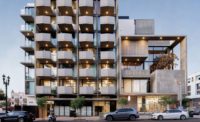With the economies of many African countries growing rapidly, the continent's cities are beginning to reflect the enormous potential for creating a new urban realm.
 |
| Photo: © Damon Winter/The New York Times |
| By mid-century, 60 percent of Africa’s booming and relatively young population will live in cities like this modern metropolis, which, with more than 5 million people, is now the second largest on the continent. |

From the air, Juba, South Sudan, the capital of Africa's newest country, looks like nothing so much as a giant village, sprawling brown, flat, and ragged from the banks of the White Nile. At first glance this might seem a most unlikely frontier for architects seeking new markets, but the closer one looks, the more this city begins to resemble a vast construction project waiting to happen.
I had been warned to carry a lot of cash with me here, because there were no international banks, much less functioning ATMs, from which to access funds. But wandering by foot “downtown” my first evening in the city, on a dusty side street I stumbled upon the gleaming local headquarters of Stanbic Bank, a subsidiary of South Africa's Standard Bank and a major presence around the continent. When I inquired, the watchmen standing guard out front informed me that the large blue glass-and-metal structure had been inaugurated by the new nation's president that very week.
This country may embody underdevelopment like few other places, but because it is swimming in oil wealth, lots of other banks will undoubtedly follow Stanbic's example in the near future—and that is just for starters.
For the time being, South Sudan's year-old government works out of a jumble of white buildings—half overgrown villas, half hastily built concrete blocks—at one end of the city's main avenue, across the road from a national stadium that comprises little more than a pair of opposing bleachers and a forlorn dirt field. Someday, perhaps soon, these will be replaced by an administrative district that will give a fresh definition to this fast-growing city of 300,000 people. Who will design and build it remains an open question.
In large part because of its newness, South Sudan is an extreme example of a phenomenon taking place all over sub-Saharan Africa. Here, a combination of some of the world's most vigorous economic growth—at least a dozen African economies have grown by 6 percent or more a year for six straight years—and the planet's fastest urbanization rates are creating new cities and reshaping existing ones on a scale exceeded only by China. This phenomenon, which is likely to last at least until mid-century, is underpinned in equal parts by strong international demand for the continent's immense mineral and hydrocarbon riches and by the rapid rise of new middle classes in one country after another.
But South Sudan is an extreme example in another sense, too. Whether the country will be able to harness its resources for the huge building boom that is so clearly needed will depend on whether it can reach a modus vivendi with Sudan, the country to the north from which it recently seceded—and, just as crucially, whether its leaders can keep corruption within reasonable limits.
High political risk—involving poor governance, weak rule of law, and corruption—is a problem in many African countries. Yet international players are increasingly attracted to the continent's markets, including in the construction industry, because the demographic and economic fundamentals are so strong. By 2050, one in four working-age people in the world will be African, and 60 percent of the continent's population will live in cities, compared with about 40 percent now, according to the United Nations. Because Africa's overall population rate is zooming, there will be three times as many urban dwellers as there are today. Like people everywhere, a great many of them will demand to shop in modern malls, to stay in international-style hotels, and to live and work in modern buildings.
In the last two years, traveling widely around the continent while researching a book about China's booming relations with Africa, I have seen glimpses of this emerging urban realm in city after city. New expressways deliver motorists to the hearts of fast-growing capitals like Windhoek, Namibia; Dakar, Senegal; and Bamako, Mali. Construction cranes crowd the skyline in cities as far-flung as Dar es Salaam, Tanzania; Lusaka, Zambia; Accra, Ghana; and Maputo, Mozambique.
The last of these countries, and places like Guinea, Liberia, and Sierra Leone, are now embarking on huge, resource-fueled booms that stand to transform decrepit and overcrowded capitals. Thanks to massive coal exports and vast discoveries of natural gas, Mozambique has enjoyed an annual average growth rate of 7.2 percent for a decade. The resulting optimism has spurred the first big building push in Maputo, the elegant but hitherto sleepy seaside capital, since independence from Portugal in 1975.
In Nigeria's commercial capital, Lagos—which could become the world's third-largest city by mid-century, with a population approaching 40 million—an ambitious light-rail system is under construction, along with an entirely new district that will be half financial center and half high-end oceanfront residential neighborhood. The land for this bold project is being reclaimed from the sea.
Meanwhile, south along the Atlantic coast, Angola has seen some of the fastest economic growth in the world, averaging over 17 percent per year between 2004 and 2008, with 9 percent growth expected next year. Large swaths of the capital, Luanda, are being completely rebuilt, with modern new quarters rising to replace blighted squatter settlements. At the same time, the city's colonial Portuguese seafront, which compares for scenic value with Havana's more famous MalecÓn, is being lavishly restored and refurbished.
However ambitious, ongoing building spurts like these represent only a small foretaste of the construction and property boom that is likely in store for much of sub-Saharan Africa.
To get a sense of what is to come, it helps to consider the not-so-distant past. Tanzania, Côte d'Ivoire, and especially Nigeria all stand out as exemplars of a kind of boldness of urban development that few outsiders associate with Africa. In each of these countries, new capitals were decreed and built, each more ambitious than the last—beginning with Dodoma, Tanzania, in the 1970s and followed by Yamoussoukro, Côte d'Ivoire, in the 1980s and Abuja, Nigeria, in the early 1990s.
Yamoussoukro's international claim to fame ever since has been the largest church in the world, the Basilica of Our Lady of Peace, built by the country's late founding father, Félix Houphouët-Boigny, and finished in 1989 at a reported cost of $300 million. The city contains other monumental structures, such as a presidential palace made famous in the writings of V.S. Naipaul, a large five-star hotel complex, and, most recently, a National Assembly building. But Yamoussoukro has never drawn large-scale migration from other parts of the country, and its avenues, some as broad as Paris's Champs-Élysées, remain eerily free of traffic.
By contrast, Abuja, the capital that Nigeria began to build in 1991, has quickly become one of the biggest cities in Africa's most populous country. When I first visited there, in 1994, the neighborhoods meant to house newly arrived civil servants emerged from an uninspiring grid and still had a rough and unfinished feel to them. Back then, the streets were also largely deserted. The city's two big international hotels were the main focus of life and housed senior officials—and sometimes even their domestic staffs, who cooked their meals in the rooms—for long-term stays.
Although the official census puts Abuja's population at just over a million, Nigerian demographers say that the true number today approaches 5 million, and the city has quickly established itself as one of the biggest and busiest construction markets on the continent, with office buildings, modern housing complexes, and shopping centers rising everywhere.
Unless they do more to join the ongoing building fray, students of African urbanism may look back someday at Yamoussoukro and Abuja as the high-water mark for Western architecture and city design in Africa. With the end of the Cold War, the West's engagement with the continent faded sharply, leaving a void that China has moved energetically to fill since the turn of the century.
Nowadays, there are few major African cities without significant Chinese building projects underway, and the Chinese construction firms plying these markets have moved well beyond their initial penchant for large stadiums to sleek airports, government ministries, hospitals, national theaters, and new central-business-district complexes.
Perhaps the best measure of China's ambition can be found in oil-rich Angola, where the China International Trust and Investment Corporation (CITIC) is completing work on an entire satellite city at Kilamba, 18 miles from Luanda. This new urban development, comprising 750 eight-story apartment buildings, a dozen schools, and more than 100 retail spaces, was built at a cost of $3.5 billion in a mere three years.
With their own economy now slowing, Chinese builders are looking to Africa to pick up the slack, pushing plans for similar satellite cities in numerous markets including Nigeria, Kenya, and Mozambique. Although China has drawn controversy and criticism for employing large numbers of its own workers in the construction of projects like these, its biggest advantage probably lies in the low financing costs its companies can offer because of support from China's state-owned banks.
In most of their big projects in Africa, Chinese companies have used designs that convey an off-the-shelf feel. Their building costs are low, but it is the lack of originality and the rapid execution that have fed a widespread perception among Africans of cheap quality and even poor durability.
Though China is aggressively pursuing development, certain competing players are undaunted, seeing huge, untapped possibilities. Here South Africa is the best example, with its architecture and building firms ranging ever farther in new markets, notably Nigeria.
The opportunities for international architecture and construction firms are potentially enormous. If, as more and more experts are beginning to predict, Africa can sustain its recent strong economic growth, what has long been discounted as the world's poorest continent will instead become the scene for globalization's next big act.
Howard W. French, an associate professor at the Columbia University Graduate School of Journalism, is the author of A Continent for the Taking: The Tragedy and Hope of Africa.



Post a comment to this article
Report Abusive Comment